Knowledge-Based Smart City Service System
Abstract
1. Introduction
- A definition of a conceptual and technological framework, namely, the Smart City Service System (SCSS), which embeds all the principles of the service science in the smart city;
- A discussion of data sharing within the city infrastructure as the main element for bringing smartness to the city;
- A first, prototypical solution implementing the conceptual framework.
2. Related Works
3. Knowledge-Based Smart City Service System: The Conceptual Framework
- Instrumentation that is able to capture live real-world data through sensors (both digital and virtual), personal devices, applications, cameras, smartphones, web, etc.;
- Integration of the information obtained by the instrumentation across multiple processes, systems, and organizations;
- Intelligence, which means the use of complex analytics, modeling, optimization, and visualization to improve the decision-making processes.
4. An Ontology-Based Implementation of the Smart City Service System
- : Each actor shares its data with the organization to which it belongs. A set of instruments is used to produce and gather the data, such as physical sensors, information systems, web, applications, etc.;
- : Each organization receives the data and may filter it (e.g, it can clean data, filter sensitive data, etc.) and then shares the data. The data is represented as a set of variables ;
- : Each variable is mapped to a specific concept of the ontological model. A mapping function is used to map each variable to one of the classes, properties or values of the ontological model. The obtained semantic data are stored in the city data layer.
- : Retrieving and extracting the data from the city data layer;
- : Processing the extracted data and classify/cluster the data in different classes ;
- : If needed, further processing the data of each class using ontology reasoning. For instance, the data of class can be further split into subclasses .
- : Some tasks are performed on the subclasses S identified by the process (e.g., count elements, compute statistical measures, find specific events, make a recommendation to the decision-makers, etc.)
- : The decision-makers evaluate the results of to make a decision;
- : The decision-makers complete their decisions and perform some actions that will cause changes in the SCSS (e.g., modification of some services, delivery of new services, etc.) that should be visible by the actors and organizations that have shared their data in process .
4.1. The Knowledge Representation Model
4.1.1. Activity 1: Ontology Search
4.1.2. Activity 2: Ontology Assessment
4.1.3. Activity 3: Ontology Comparison
4.1.4. Activity 4: Ontology Selection
4.1.5. Activity 5: Ontology Integration
5. Evaluation
5.1. Case Study: Local Public Transportation
5.1.1. Gathering Process
5.1.2. Classification Process
5.1.3. Decision-Making Process
5.2. Ontology Evaluation with OOPS
5.3. Evaluation of the Situation Awareness Using SAGAT
5.3.1. Experimental Setting
5.3.2. Results
6. Conclusions
Author Contributions
Funding
Conflicts of Interest
References
- Bakıcı, T.; Almirall, E.; Wareham, J. A Smart City Initiative: The Case of Barcelona. J. Knowl. Econ. 2013, 4, 135–148. [Google Scholar] [CrossRef]
- Colace, F.; Lombardi, M.; Pascale, F.; Santaniello, D. A multi-level approach for forecasting critical events in smart cities. In Proceedings of the DMSVIVA 2018: 24th International DMS Conference on Visualization and Visual Languages, Redwood City, CA, USA, 29–30 June 2018; pp. 31–35. [Google Scholar] [CrossRef]
- Casillo, M.; Clarizia, F.; D’Aniello, G.; De Santo, M.; Lombardi, M.; Santaniello, D. CHAT-Bot: A cultural heritage aware teller-bot for supporting touristic experiences. Pattern Recognit. Lett. 2020, 131, 234–243. [Google Scholar] [CrossRef]
- Clarizia, F.; Colace, F.; De Santo, M.; Lombardi, M.; Pascale, F.; Santaniello, D.; Tuker, A. A multilevel graph approach for rainfall forecasting: A preliminary study case on London area. Concurr. Comput. 2020, 32, e5289. [Google Scholar] [CrossRef]
- Hidayat, T.; Suhardi; Kurniawan, N.B. Smart city service system engineering based on microservices architecture: Case study: Government of tangerang city. In Proceedings of the 2017 International Conference on ICT For Smart Society (ICISS), Tangerang, Indonesia, 18–19 September 2017; pp. 1–7. [Google Scholar] [CrossRef]
- Polese, F.; Botti, A.; Monda, A.; Grimaldi, M. Smart City as a Service System: A Framework to Improve Smart Service Management. J. Serv. Sci. Manag. 2019, 12, 1–16. [Google Scholar] [CrossRef]
- Endsley, M.R. Toward a Theory of Situation Awareness in Dynamic Systems. Hum. Factors 1995, 37, 32–64. [Google Scholar] [CrossRef]
- Endsley, M.R. Situation awareness global assessment technique (SAGAT). In Proceedings of the IEEE 1988 National Aerospace and Electronics Conference, Dayton, OH, USA, 23–27 May 1988; pp. 789–795. [Google Scholar] [CrossRef]
- Ojo, A.; Dzhusupova, Z.; Curry, E. Exploring the Nature of the Smart Cities Research Landscape. In Smarter as the New Urban Agenda: A Comprehensive View of the 21st Century City; Gil-Garcia, J.R., Pardo, T.A., Nam, T., Eds.; Springer International Publishing: Cham, Switzerland, 2016; pp. 23–47. [Google Scholar]
- Clement, S.J.; McKee, D.W.; Xu, J. Service-Oriented Reference Architecture for Smart Cities. In Proceedings of the 2017 IEEE Symposium on Service-Oriented System Engineering (SOSE), San Francisco, CA, USA, 6–9 April 2017; pp. 81–85. [Google Scholar] [CrossRef]
- Harrison, C.; Eckman, B.; Hamilton, R.; Hartswick, P.; Kalagnanam, J.; Paraszczak, J.; Williams, P. Foundations for Smarter Cities. IBM J. Res. Dev. 2010, 54, 1–16. [Google Scholar] [CrossRef]
- Espinoza-Arias, P.; Poveda-Villalón, M.; García-Castro, R.; Corcho, O. Ontological Representation of Smart City Data: From Devices to Cities. Appl. Sci. 2018, 9, 32. [Google Scholar] [CrossRef]
- Poveda Villalón, M.; García Castro, R.; Gómez-Pérez, A. Building an ontology catalogue for smart cities. eWork and eBusiness in Architecture, Engineering and Construction. In Proceedings of the ECPPM 2014, 10th European Conference on Product & Process Modelling, Vienna, Austria, 17–19 September 2014. [Google Scholar]
- Gyrard, A.; Atemezing, G.; Bonnet, C.; Boudaoud, K.; Serrano, M. Reusing and Unifying Background Knowledge for Internet of Things with LOV4IoT. In Proceedings of the 2016 IEEE 4th International Conference on Future Internet of Things and Cloud (FiCloud), Vienna, Austria, 22–24 August 2016; pp. 262–269. [Google Scholar] [CrossRef]
- Gyrard, A.; Zimmermann, A.; Sheth, A.P. Building IoT-Based Applications for Smart Cities: How Can Ontology Catalogs Help? IEEE Internet Things J. 2018, 5, 3978–3990. [Google Scholar] [CrossRef]
- Spoladore, D.; Mahroo, A.; Trombetta, A.; Sacco, M. Comfont: A semantic framework for indoor comfort and energy saving in smart homes. Electronics 2019, 8, 1449. [Google Scholar] [CrossRef]
- Lork, C.; Choudhary, V.; Ul Hassan, N.; Tushar, W.; Yuen, C.; Ng, B.; Wang, X.; Liu, X. An Ontology-Based Framework for Building Energy Management with IoT. Electronics 2019, 8, 485. [Google Scholar] [CrossRef]
- D’Aniello, G.; Gaeta, M.; Hong, T.P. Effective Quality-Aware Sensor Data Management. IEEE Trans. Emerg. Top. Comput. Intell. 2018, 2, 65–77. [Google Scholar] [CrossRef]
- Agarwal, R.; Fernandez, D.G.; Elsaleh, T.; Gyrard, A.; Lanza, J.; Sanchez, L.; Georgantas, N.; Issarny, V. Unified IoT ontology to enable interoperability and federation of testbeds. In Proceedings of the 2016 IEEE 3rd World Forum on Internet of Things (WF-IoT)(WF-IOT), Reston, VA, USA, 12–14 December 2016; pp. 70–75. [Google Scholar] [CrossRef]
- Müller, H.; Cabral, L.; Morshed, A.; Shu, Y. From RESTful to SPARQL: A Case Study on Generating Semantic Sensor Data. In Proceedings of the 6th International Workshop on Semantic Sensor Networks Co-Located with the 12th International Semantic Web Conference (ISWC 2013), Sydney, Australia, 22 October 2013; pp. 51–66. [Google Scholar]
- Lefrançois, M. Planned ETSI SAREF Extensions based on the W3C&OGC SOSA/SSN-compatible SEAS Ontology Patterns. In Proceedings of the Workshop on Semantic Interoperability and Standardization in the IoT, SIS-IoT, Amsterdam, The Netherlands, 11 September 2017. [Google Scholar]
- Kazmi, A.; Jan, Z.; Zappa, A.; Serrano, M. Overcoming the Heterogeneity in the Internet of Things for Smart Cities. In Interoperability and Open-Source Solutions for the Internet of Things; Podnar Žarko, I., Broering, A., Soursos, S., Serrano, M., Eds.; Springer International Publishing: Cham, Switzerland, 2017; pp. 20–35. [Google Scholar]
- Lécué, F.; Tallevi-Diotallevi, S.; Hayes, J.; Tucker, R.; Bicer, V.; Sbodio, M.L.; Tommasi, P. STAR-CITY: Semantic Traffic Analytics and Reasoning for CITY. In Proceedings of the 19th International Conference on Intelligent User Interfaces, Haifa, Israel, 24–27 February 2014; pp. 179–188. [Google Scholar] [CrossRef]
- Succar, B. Building information modelling framework: A research and delivery foundation for industry stakeholders. Autom. Constr. 2009, 18, 357–375. [Google Scholar] [CrossRef]
- Gunay, A.; Akcay, O.; Altan, M.O. Building a semantic based public transportation geoportal compliant with the INSPIRE transport network data theme. Earth Sci. Inform. 2014, 7, 25–37. [Google Scholar] [CrossRef]
- Bellini, P.; Benigni, M.; Billero, R.; Nesi, P.; Rauch, N. Km4City ontology building vs data harvesting and cleaning for smart-city services. J. Vis. Lang. Comput. 2014, 25, 827–839. [Google Scholar] [CrossRef]
- Maglio, P.P.; Spohrer, J. Fundamentals of service science. J. Acad. Mark. Sci. 2008, 36, 18–20. [Google Scholar] [CrossRef]
- Lusch, R.F.; Vargo, S.L. Service-dominant logic: What it is, what it is not, what it might be. In The Service-Dominant Logic of Marketing; Routledge: New York, NY, USA, 2014; pp. 61–74. [Google Scholar]
- Vargo, S.L.; Lusch, R.F.; Akaka, M.A. Advancing Service Science with Service-Dominant Logic. In Handbook of Service Science; Maglio, P.P., Kieliszewski, C.A., Spohrer, J.C., Eds.; Springer: Boston, MA, USA, 2010; pp. 133–156. [Google Scholar]
- Spohrer, J.; Kwan, S.K. Service Science, Management, Engineering, and Design (SSMED): An Emerging Discipline - Outline & References. Int. J. Inf. Syst. Serv. Sect. 2009, 1, 1–31. [Google Scholar]
- Bittner, T.; Donnelly, M.; Winter, S. Ontology and semantic interoperability. In Large-scale 3D data integration: Challenges and Opportunities; CRC Press: Boca Raton, FL, USA, 2005; pp. 139–160. [Google Scholar]
- Suárez-Figueroa, M.C.; Gómez-Pérez, A.; Fernández-López, M. The NeOn Methodology framework: A scenario-based methodology for ontology development. Appl. Ontol. 2015, 10, 107–145. [Google Scholar] [CrossRef]
- Borgo, S.; Masolo, C. Ontological Foundations of DOLCE. In Theory and Applications of Ontology: Computer Applications; Poli, R., Healy, M., Kameas, A., Eds.; Springer: Dordrecht, The Netherlands, 2010; pp. 279–295. [Google Scholar]
- Niles, I.; Pease, A. Towards a standard upper ontology. In Proceedings of the International Conference on Formal Ontology in Information Systems-Volume 2001, Ogunquit, ME, USA, 17–19 October 2001; pp. 2–9. [Google Scholar]
- Uceda-Sosa, R.; Srivastava, B.; Schloss, R.J. Building a Highly Consumable Semantic Model for Smarter Cities. In Proceedings of the AI for an Intelligent Planet, Barcelona, Spain, 18 July 2011; pp. 3:1–3:8. [Google Scholar]
- Martin, D.; Burstein, M.; Mcdermott, D.; Mcilraith, S.; Paolucci, M.; Sycara, K.; Mcguinness, D.L.; Sirin, E.; Srinivasan, N. Bringing semantics to web services with OWL-S. World Wide Web 2007, 10, 243–277. [Google Scholar] [CrossRef]
- Compton, M.; Barnaghi, P.; Bermudez, L.; GarcÃa-Castro, R.; Corcho, O.; Cox, S.; Graybeal, J.; Hauswirth, M.; Henson, C.; Herzog, A.; et al. The SSN ontology of the W3C semantic sensor network incubator group. J. Web Semant. 2012, 17, 25–32. [Google Scholar] [CrossRef]
- Biancalana, C.; Flamini, A.; Gasparetti, F.; Micarelli, A.; Millevolte, S.; Sansonetti, G. Enhancing traditional local search recommendations with context-awareness. In Lecture Notes in Computer Science (Including Subseries Lecture Notes in Artificial Intelligence and Lecture Notes in Bioinformatics); Springer: Berlin/Heidelberg, Germany, 2011; Volume 6787 LNCS, pp. 335–340. [Google Scholar] [CrossRef]
- Poveda-Villalón, M.; Gómez-Pérez, A.; Suárez-Figueroa, M.C. OOPS! (OntOlogy Pitfall Scanner!): An On-line Tool for Ontology Evaluation. Int. J. Semant. Web Inf. Syst. 2014, 10, 7–34. [Google Scholar] [CrossRef]
- Endsley, M.R. Direct measurement of situation awareness: Validity and use of SAGAT. In Situational Awareness; Routledge: London, UK, 2017; pp. 129–156. [Google Scholar]
- Schmöcker, J.D.; Bell, M.G.H.; Lam, W.H.K. Importance of public transport. J. Adv. Transp. 2004, 38, 1–4. [Google Scholar] [CrossRef]
- Gómez-Pérez, A. Ontology Evaluation. In Handbook on Ontologies; Staab, S., Studer, R., Eds.; Springer: Berlin/Heidelberg, Germany, 2004; pp. 251–273. [Google Scholar]
- Gangemi, A.; Catenacci, C.; Ciaramita, M.; Lehmann, J. Modelling Ontology Evaluation and Validation. In The Semantic Web: Research and Applications; Sure, Y., Domingue, J., Eds.; Springer: Berlin/Heidelberg, Germany, 2006; pp. 140–154. [Google Scholar]
- Duque-Ramos, A.; Fernández-Breis, J.T.; Stevens, R.; Aussenac-Gilles, N. OQuaRE: A SQuaRE-based Approach for Evaluating the Quality of Ontologies. J. Res. Pract. Inf. Technol. 2011, 43, 159–176. [Google Scholar]
- Burton-Jones, A.; Storey, V.C.; Sugumaran, V.; Ahluwalia, P. A semiotic metrics suite for assessing the quality of ontologies. Data Knowl. Eng. 2005, 55, 84–102. [Google Scholar] [CrossRef]
- Djedidi, R.; Aufaure, M.A. ONTO-EVOAL an Ontology Evolution Approach Guided by Pattern Modeling and Quality Evaluation. In Foundations of Information and Knowledge Systems; Link, S., Prade, H., Eds.; Springer: Berlin/Heidelberg, Germany, 2010; pp. 286–305. [Google Scholar]
- Endsley, M.R. Designing for Situation Awareness: An Approach to User-Centered Design, Second Edition, 2nd ed.; CRC Press, Inc.: Boca Raton, FL, USA, 2011. [Google Scholar]
- D’Aniello, G.; Gaeta, A.; Loia, V.; Orciuoli, F. Integrating GSO and SAW ontologies to enable Situation Awareness in Green Fleet Management. In Proceedings of the 2016 IEEE International Multi-Disciplinary Conference on Cognitive Methods in Situation Awareness and Decision Support, CogSIMA 2016, San Diego, CA, USA, 21–25 March 2016; pp. 138–144. [Google Scholar] [CrossRef]
- D’Aniello, G.; Loia, V.; Orciuoli, F. An Adaptive System Based on Situation Awareness for Goal-Driven Management in Container Terminals. IEEE Intell. Transp. Syst. Mag. 2019, 11, 126–136. [Google Scholar] [CrossRef]
- Chang, M.; D’Aniello, G.; Gaeta, M.; Orciuoli, F.; Sampson, D.; Simonelli, C. Building Ontology-Driven Tutoring Models for Intelligent Tutoring Systems Using Data Mining. IEEE Access 2020, 8, 48151–48162. [Google Scholar] [CrossRef]
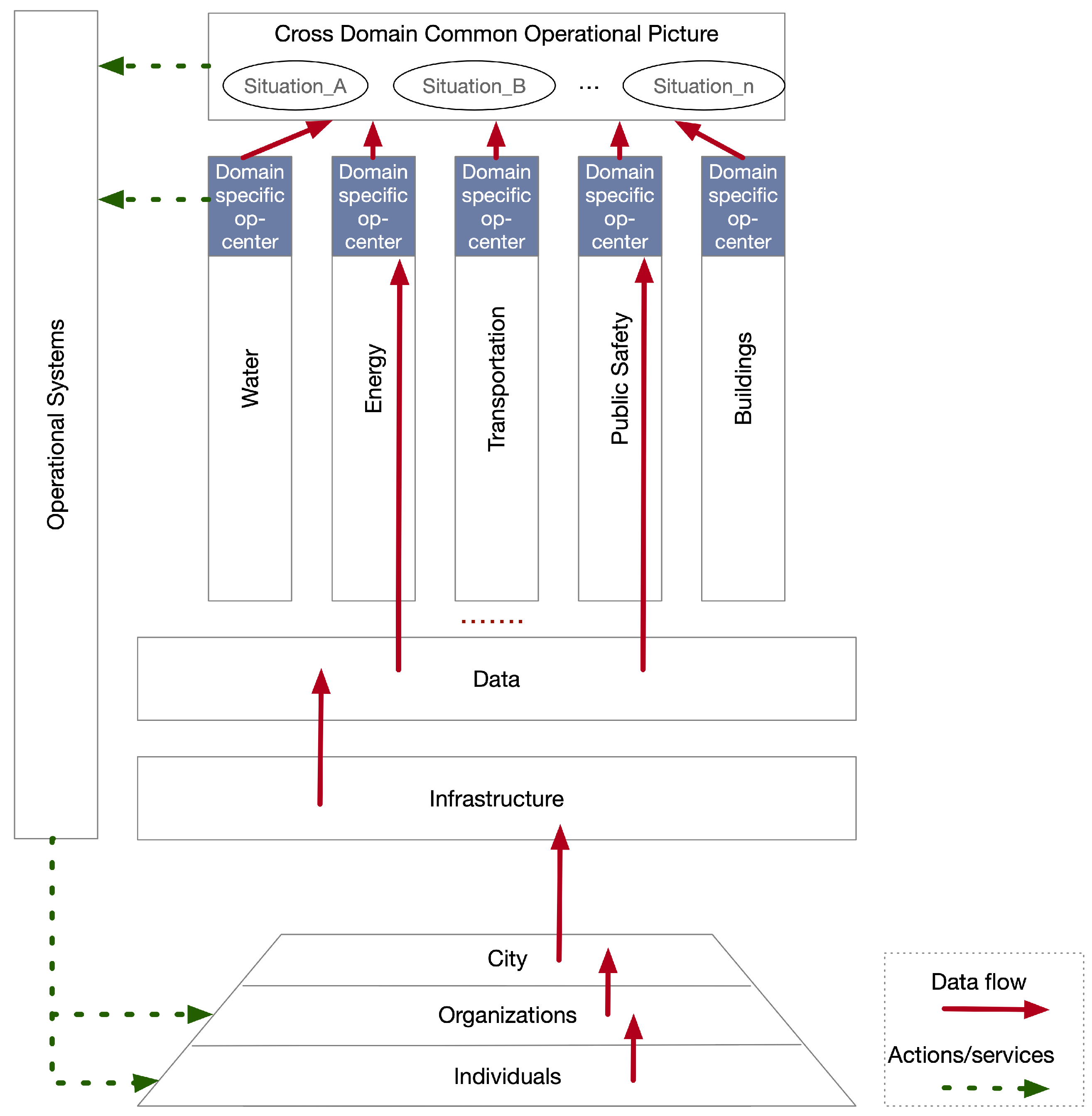
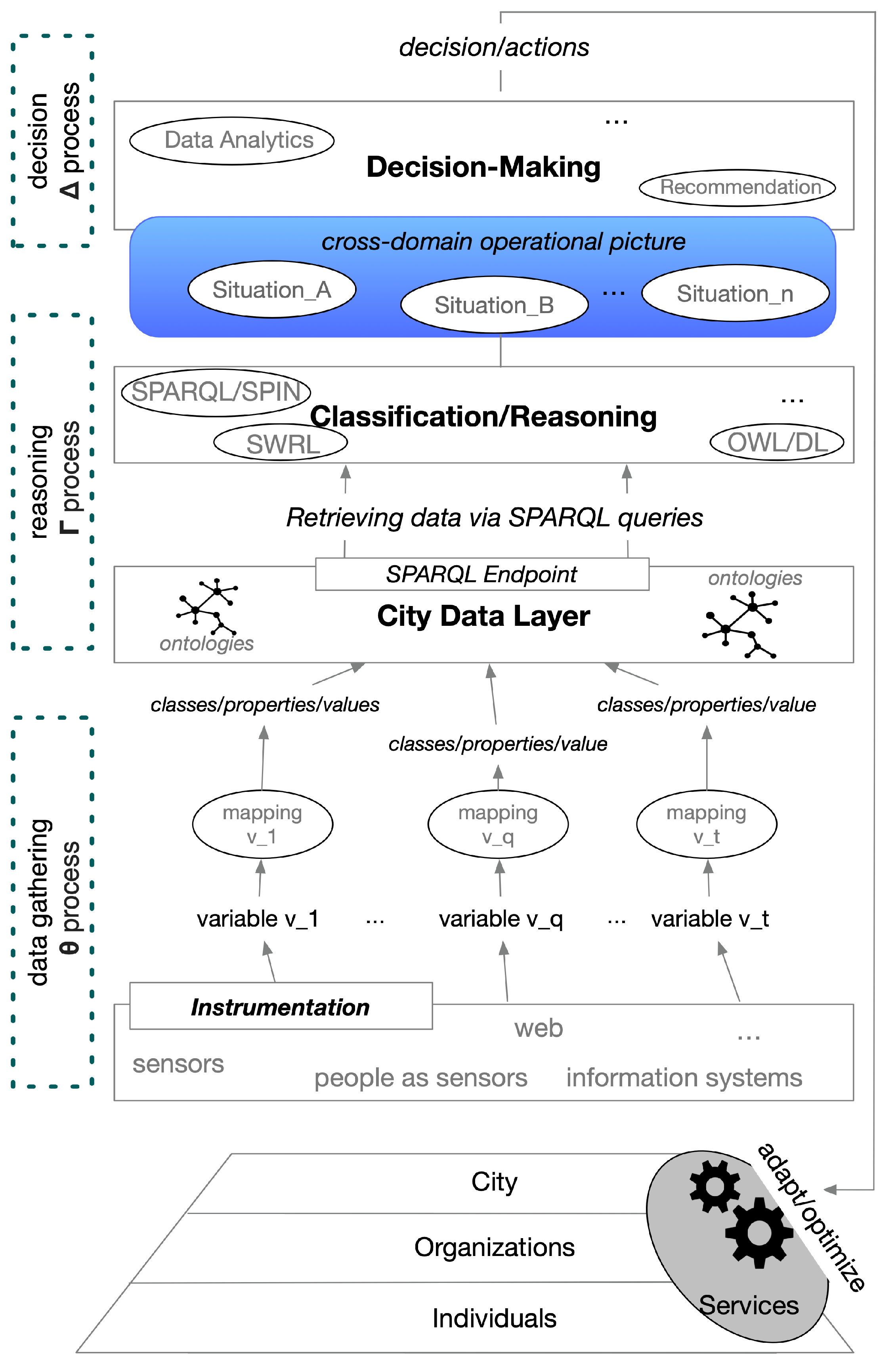
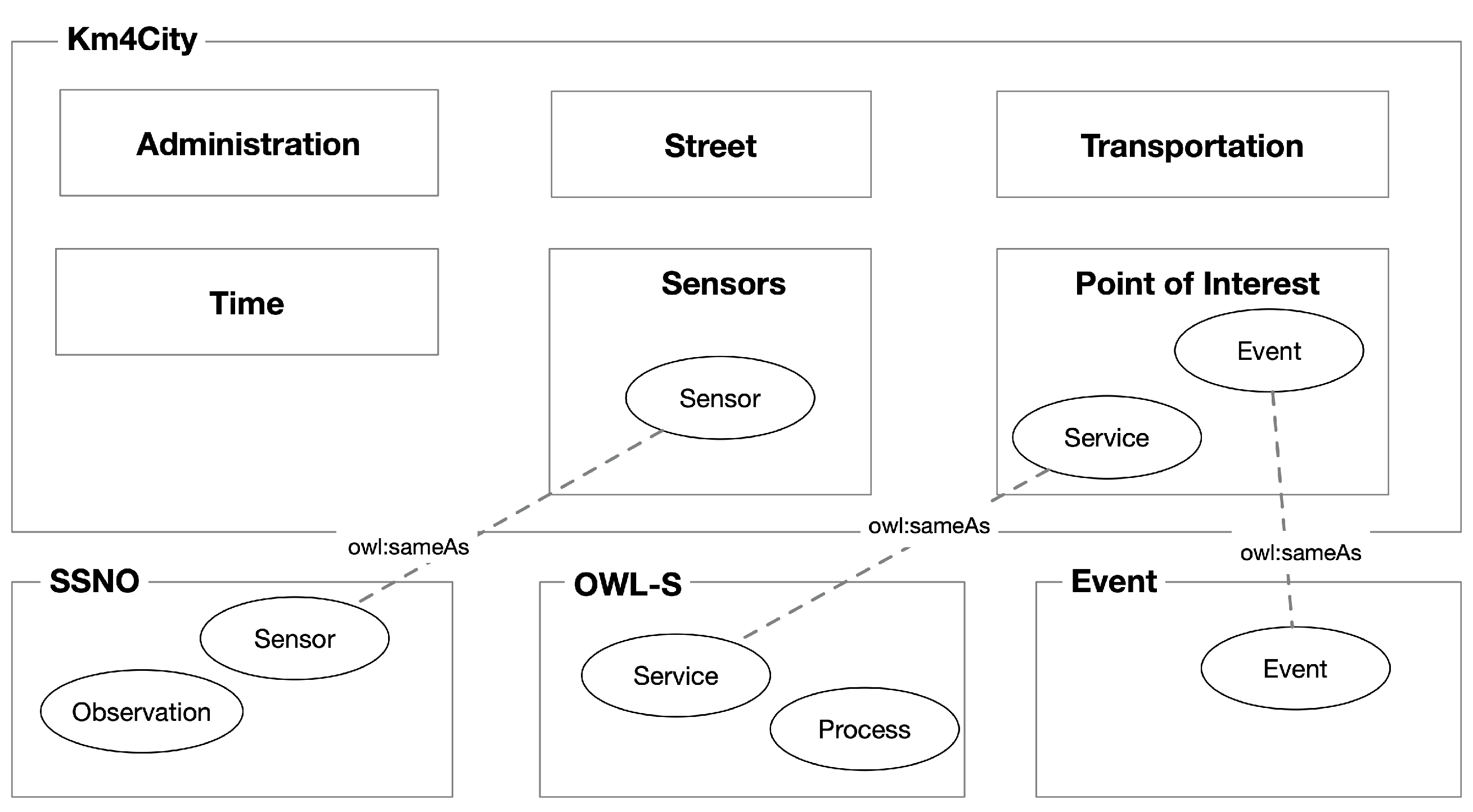
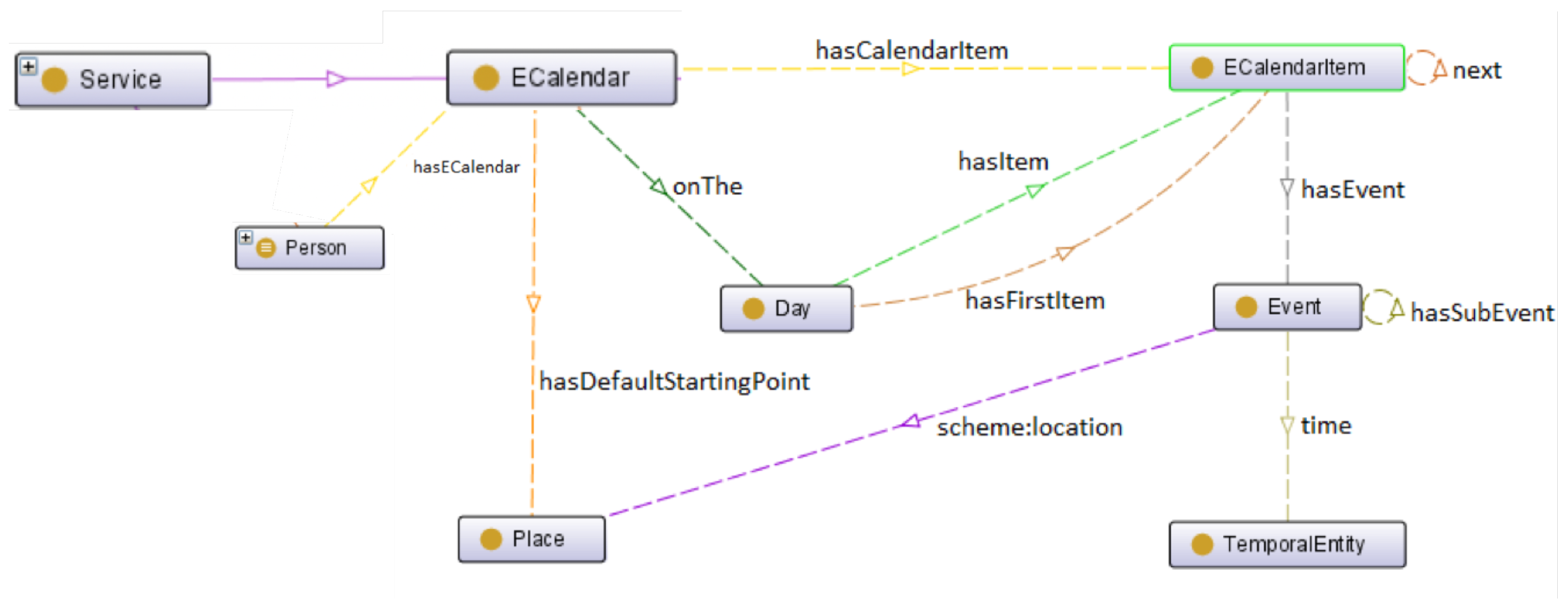


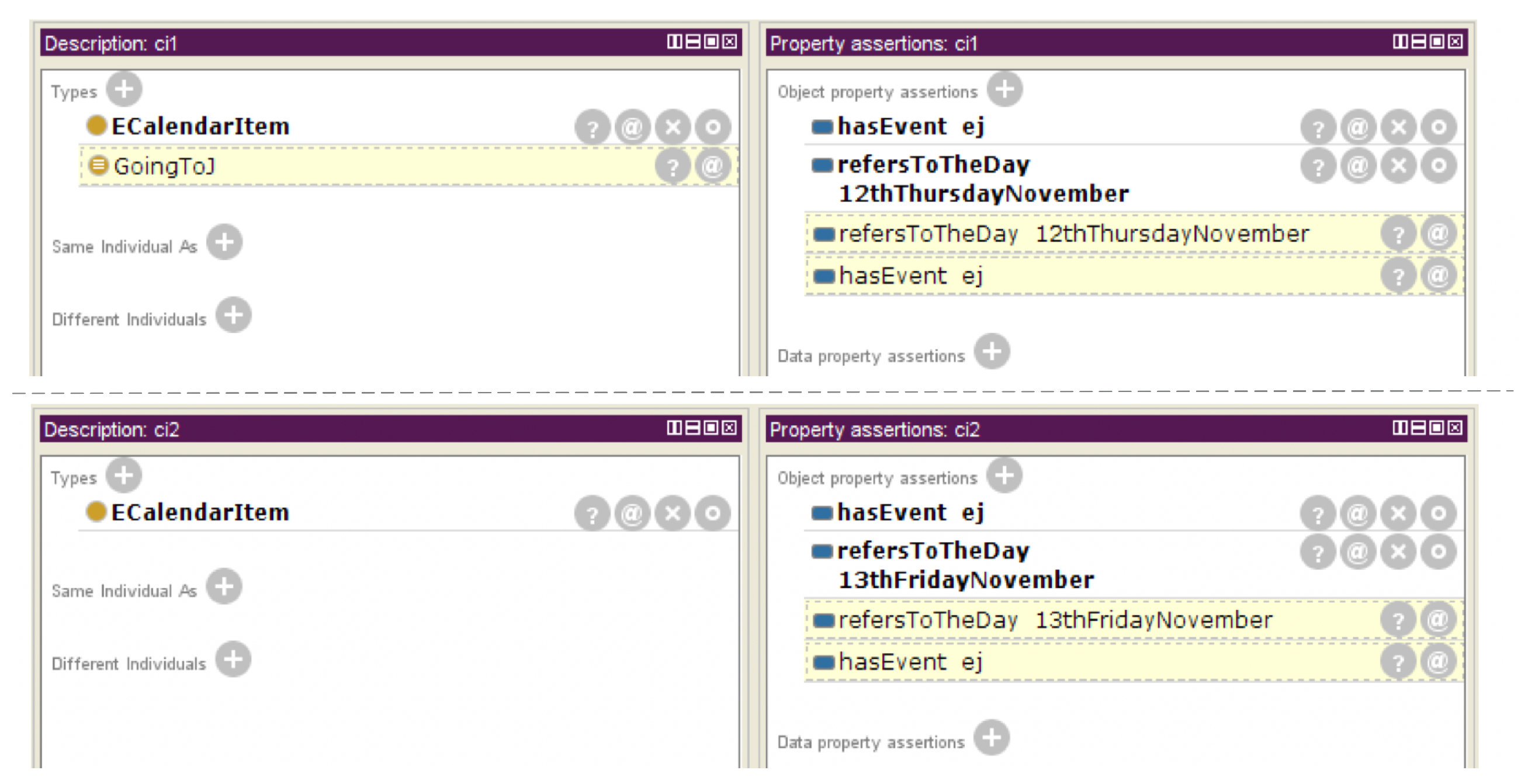
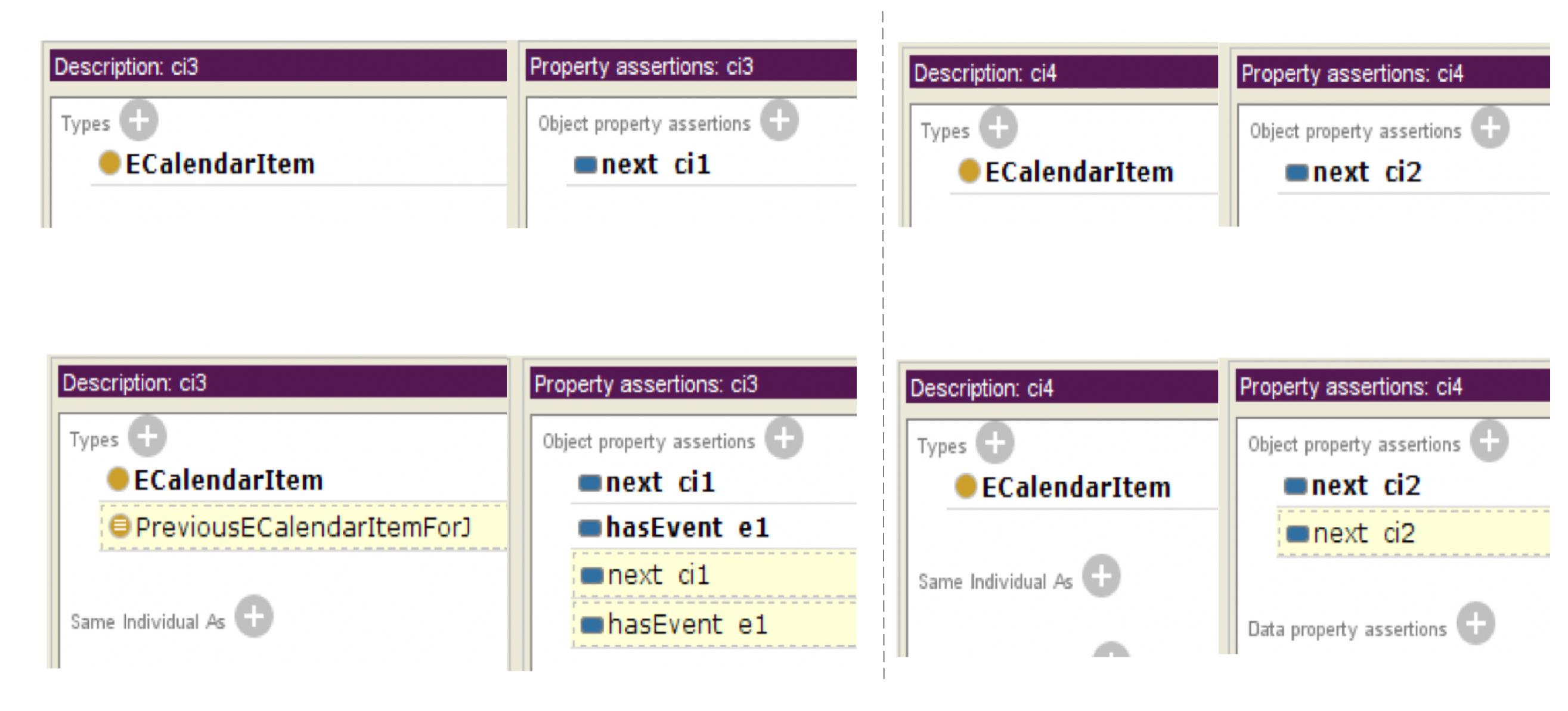


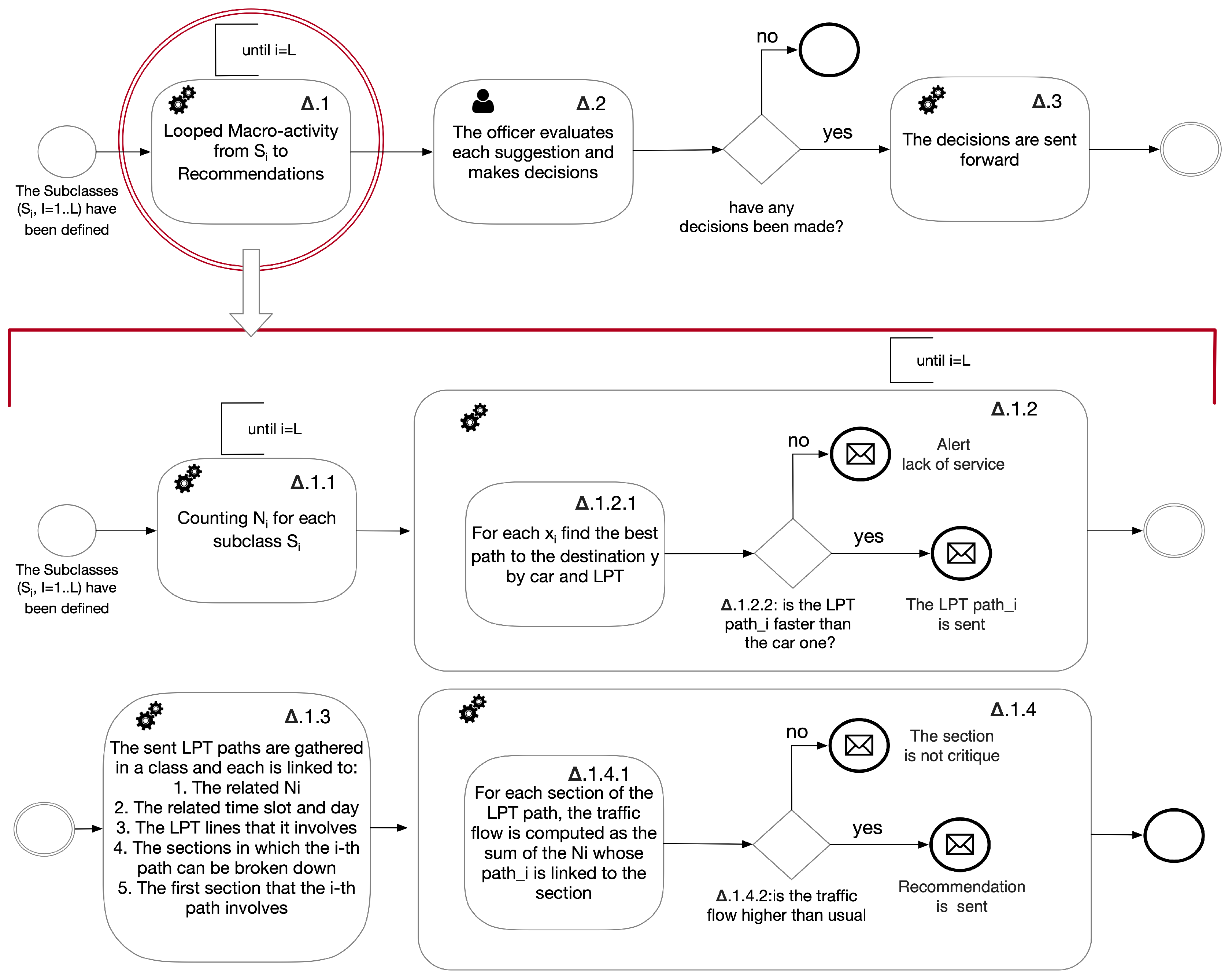
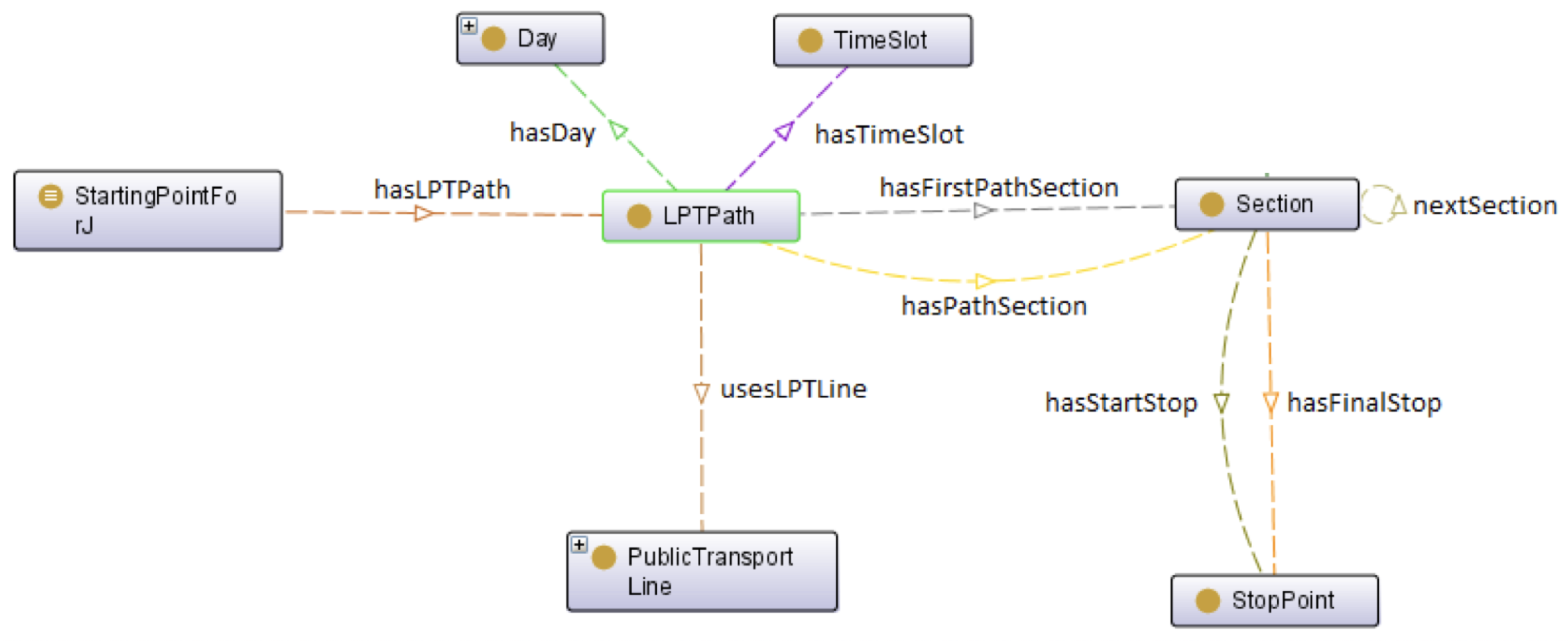
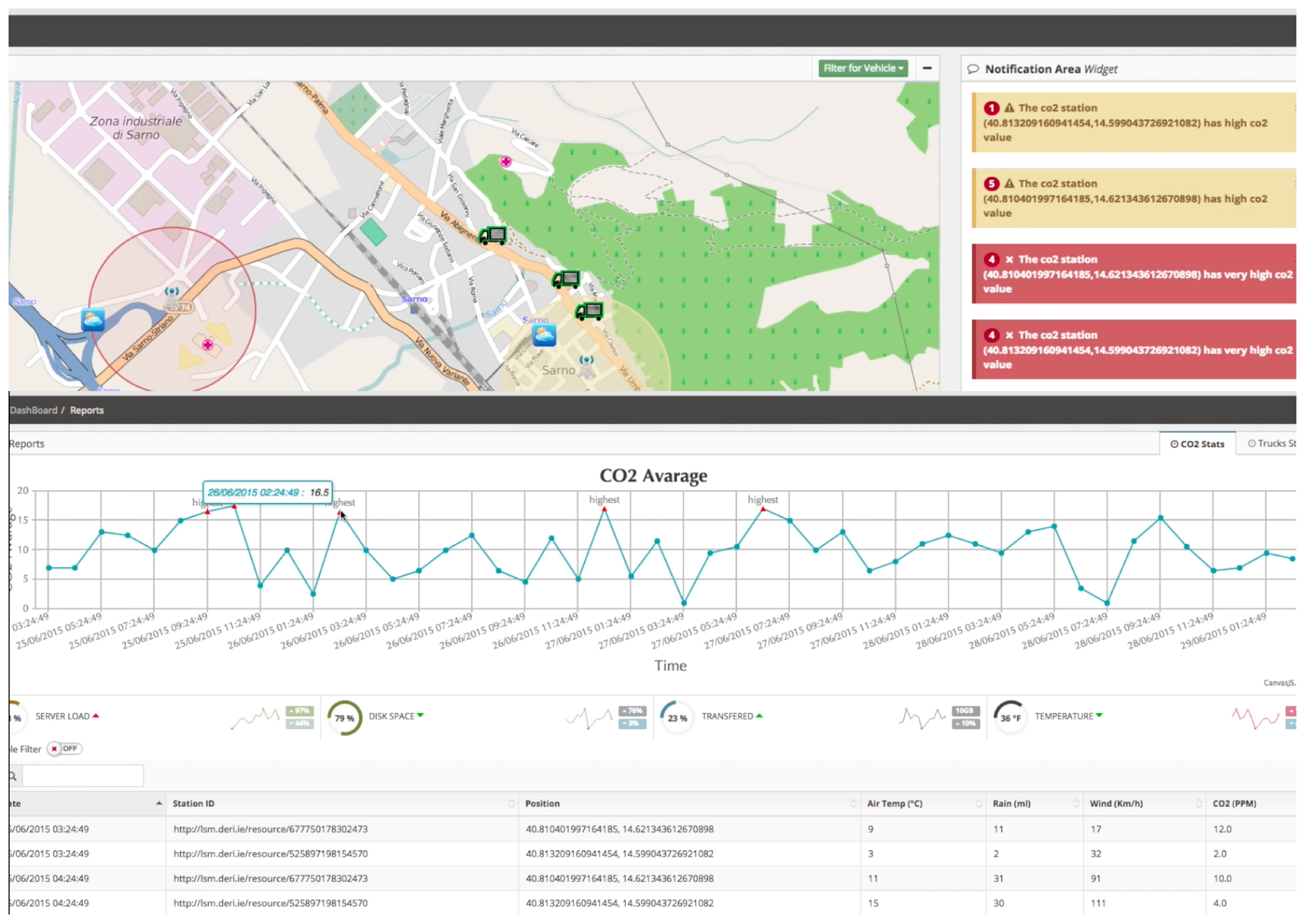
| Variable | Class |
|---|---|
| Event J | event:Event |
| Place Y | km4c:Place |
| Place | km4c:Place |
| Organization | foaf:Organization |
| Person | foaf:Person |
| Calendar | ecal:ECalendar |
| Mode A Mean % (SD%) | Mode B Mean % (SD%) | |
|---|---|---|
| SA Level 1 | 70.52 (13.88) | 82.47 (9.24) |
| SA Level 2 | 68.13 (13.62) | 78.27 (10.39) |
| SA Level 3 | 64.73 (19.73) | 78.07 (9.56) |
| SA Overall | 67.79 (11.19) | 79.60 (5.27) |
© 2020 by the authors. Licensee MDPI, Basel, Switzerland. This article is an open access article distributed under the terms and conditions of the Creative Commons Attribution (CC BY) license (http://creativecommons.org/licenses/by/4.0/).
Share and Cite
D’Aniello, G.; Gaeta, M.; Orciuoli, F.; Sansonetti, G.; Sorgente, F. Knowledge-Based Smart City Service System. Electronics 2020, 9, 965. https://doi.org/10.3390/electronics9060965
D’Aniello G, Gaeta M, Orciuoli F, Sansonetti G, Sorgente F. Knowledge-Based Smart City Service System. Electronics. 2020; 9(6):965. https://doi.org/10.3390/electronics9060965
Chicago/Turabian StyleD’Aniello, Giuseppe, Matteo Gaeta, Francesco Orciuoli, Giuseppe Sansonetti, and Francesca Sorgente. 2020. "Knowledge-Based Smart City Service System" Electronics 9, no. 6: 965. https://doi.org/10.3390/electronics9060965
APA StyleD’Aniello, G., Gaeta, M., Orciuoli, F., Sansonetti, G., & Sorgente, F. (2020). Knowledge-Based Smart City Service System. Electronics, 9(6), 965. https://doi.org/10.3390/electronics9060965








